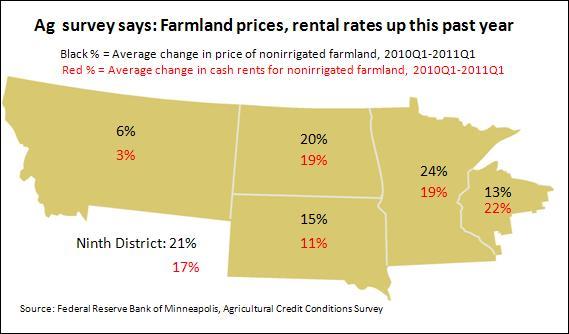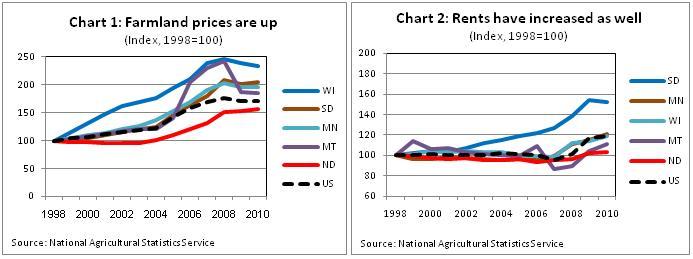The value of farmland is based largely on the value of the crops a farmer can produce on it. Recently, prices for district crops like corn, wheat and soybeans have been at historic highs, and those prices appear to be seeping into farmland values.
Bankers responding to the Minneapolis Fed’s first quarter (April) survey of agricultural credit conditions reported that prices for nonirrigated farmland increased 21 percent in the district in the first quarter of this year from a year earlier, though there were differences across states. Cash rents for farmland increased substantially over that period as well (see map).

Those increases are part of a huge runup in farmland prices and rents over the past decade, according to historical data from the U.S. Department of Agriculture’s National Agricultural Statistics Service. Though 2010 saw a slight dip in both categories, every district state has seen significant longer-term increases in farmland values (see Chart 1).
Rents have also increased over this period, though much more modestly, with the exception of South Dakota (see Chart 2). Farmland is rented by landowners to producers who want to use it to grow crops, so rental rates have to be in line with the value of what the land produces. That’s why rental rates have been ramping steeply across district states since about 2007, coinciding with the runup in commodity prices. The smaller rise in rents may be also due in part to increases in inputs costs like fuel and fertilizer. So while output prices have soared, the profit margins in farming haven’t gone up as much.

To see if land prices are in line with the rental revenues that can come from land, price-to-rent ratios offer a comparison of the two against each other (see Chart 3). It appears that while the ratio is slightly elevated, it peaked both nationally and in district states in 2007-08 and has come down slightly since then.

Joe Mahon is a Minneapolis Fed regional outreach director. Joe’s primary responsibilities involve tracking several sectors of the Ninth District economy, including agriculture, manufacturing, energy, and mining.





